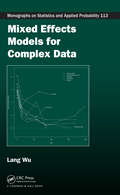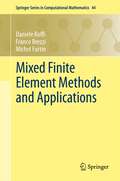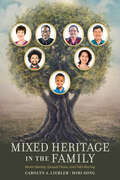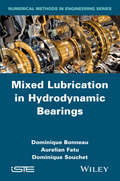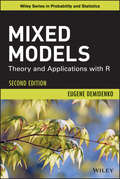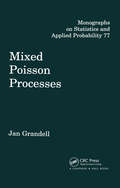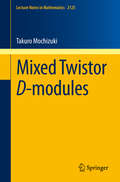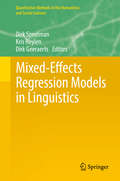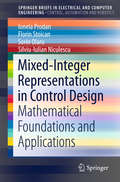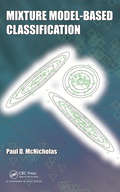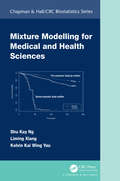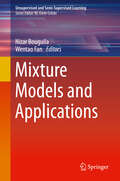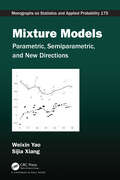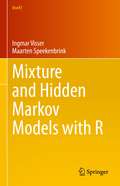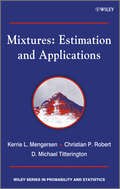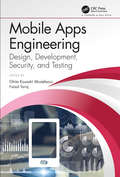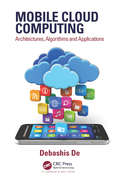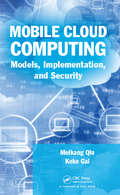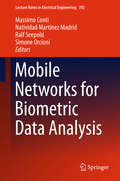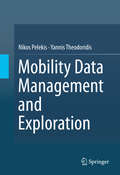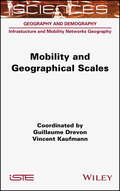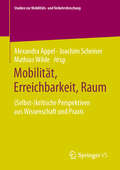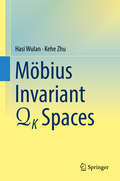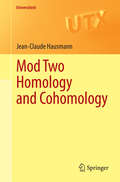- Table View
- List View
Mixed Effects Models for Complex Data
by Lang WuAlthough standard mixed effects models are useful in a range of studies, other approaches must often be used in correlation with them when studying complex or incomplete data. Mixed Effects Models for Complex Data discusses commonly used mixed effects models and presents appropriate approaches to address dropouts, missing data, measurement errors,
Mixed Effects Models for the Population Approach: Models, Tasks, Methods and Tools (Chapman & Hall/CRC Biostatistics Series)
by Marc LavielleWide-Ranging Coverage of Parametric Modeling in Linear and Nonlinear Mixed Effects ModelsMixed Effects Models for the Population Approach: Models, Tasks, Methods and Tools presents a rigorous framework for describing, implementing, and using mixed effects models. With these models, readers can perform parameter estimation and modeling across a whol
Mixed Finite Element Methods and Applications
by Franco Brezzi Daniele Boffi Michel FortinNon-standard finite element methods, in particular mixed methods, are central to many applications. In this text the authors, Boffi, Brezzi and Fortin present a general framework, starting with a finite dimensional presentation, then moving on to formulation in Hilbert spaces and finally considering approximations, including stabilized methods and eigenvalue problems. This book also provides an introduction to standard finite element approximations, followed by the construction of elements for the approximation of mixed formulations in H(div) and H(curl). The general theory is applied to some classical examples: Dirichlet's problem, Stokes' problem, plate problems, elasticity and electromagnetism.
Mixed Heritage in the Family: Racial Identity, Spousal Choice, and Childrearing
by Miri Song Carolyn LieblerAs interracial unions and multiracial people become more common in the United States, mixed-heritage people have come to be regarded by some as a bellwether of race relations in the country. Is the growth of this population a sign that we are now in a post-racial era and our racial identities no longer impact our daily lives? In Mixed Heritage in the Family,sociologists Carolyn A. Liebler and Miri Song explore how racially mixed people navigate racial boundaries as they choose spouses and raise families. Liebler and Song break new ground by being the first to combine and integrate the study of three aspects of life for people of mixed racial heritage – identity, spouse choice, and childrearing. This integrated approach reveals how complicated racial identification can be, and how it can be expressed in one’s choice of partner or in how one raises their children. The authors draw on census data and interviews with Asian-White, Black-White, and American Indian/Alaska Native-White mixed people to better understand how their identity choices are related to their choice of spouse and how they racially identify and raise their children. Increasingly, mixed people in the United States are identifying with multiple races. However, the authors find that mixed-race people are not a monolith and that how and why they identify varies considerably between and within each group. They found several common factors that influenced whether mixed-race people choose to identify as biracial, solely White, or solely as a racial minority. These factors include the history of the specific minority race in the U.S., the racial demographics of where they were raised, their social and cultural exposure to their White and non-White backgrounds, their attachment to their racial backgrounds, and how they are seen racially by others. The way mixed-heritage people identify was closely tied to the race of their spouse. However, having a White spouse did not necessarily mean the mixed-race person felt disconnected from their non-White heritage. White spouses varied in their racial consciousness and their interest in the culture of their mixed-race spouse’s minority ancestry. The spouse’s race, and the nature of racial overlap between the spouses, was also key in the racial upbringing of a mixed-heritage person’s child. In families where the parents share a minority racial heritage, couples lean into their shared ‘family race’, which guides their parenting choices and family life. Many mixed heritage parents found it important to foster racial pride in their children and combat negative racial stereotypes. Liebler and Song caution against making superficial predictions about the state of race relations in the U.S. based on an increase in the multiracial population. They show that race has not become less salient in the lives of many mixed-race people—American society is not post-racial. Mixed Heritage in the Family breaks new ground, provides compelling insights in its examination of the lives of mixed-race people, and shows how complicated racial identification can be.
Mixed Lubrication in Hydrodynamic Bearings
by Dominique Bonneau Aurelian Fatu Dominique SouchetThis Series provides the necessary elements to the development and validation of numerical prediction models for hydrodynamic bearings. This book is dedicated to the mixed lubrication.
Mixed Models
by Eugene DemidenkoPraise for the First Edition "This book will serve to greatly complement the growing number of texts dealing with mixed models, and I highly recommend including it in one's personal library."--Journal of the American Statistical Association Mixed modeling is a crucial area of statistics, enabling the analysis of clustered and longitudinal data. Mixed Models: Theory and Applications with R, Second Edition fills a gap in existing literature between mathematical and applied statistical books by presenting a powerful examination of mixed model theory and application with special attention given to the implementation in R.The new edition provides in-depth mathematical coverage of mixed models' statistical properties and numerical algorithms, as well as nontraditional applications, such as regrowth curves, shapes, and images. The book features the latest topics in statistics including modeling of complex clustered or longitudinal data, modeling data with multiple sources of variation, modeling biological variety and heterogeneity, Healthy Akaike Information Criterion (HAIC), parameter multidimensionality, and statistics of image processing.Mixed Models: Theory and Applications with R, Second Edition features unique applications of mixed model methodology, as well as:Comprehensive theoretical discussions illustrated by examples and figuresOver 300 exercises, end-of-section problems, updated data sets, and R subroutinesProblems and extended projects requiring simulations in R intended to reinforce materialSummaries of major results and general points of discussion at the end of each chapterOpen problems in mixed modeling methodology, which can be used as the basis for research or PhD dissertationsIdeal for graduate-level courses in mixed statistical modeling, the book is also an excellent reference for professionals in a range of fields, including cancer research, computer science, and engineering.
Mixed Poisson Processes
by J GrandellTo date, Mixed Poisson processes have been studied by scientists primarily interested in either insurance mathematics or point processes. Work in one area has often been carried out without knowledge of the other area. Mixed Poisson Processes is the first book to combine and concentrate on these two themes, and to distinguish between the notions of distributions and processes. The first part of the text gives special emphasis to the estimation of the underlying intensity, thinning, infinite divisibility, and reliability properties. The second part is, to a greater extent, based on Lundberg's thesis.
Mixed Twistor D-modules
by Takuro MochizukiWe introduce mixed twistor D-modules and establish their fundamental functorial properties. We also prove that they can be described as the gluing of admissible variations of mixed twistor structures. In a sense, mixed twistor D-modules can be regarded as a twistor version of M. Saito's mixed Hodge modules. Alternatively, they can be viewed as a mixed version of the pure twistor D-modules studied by C. Sabbah and the author. The theory of mixed twistor D-modules is one of the ultimate goals in the study suggested by Simpson's Meta Theorem and it would form a foundation for the Hodge theory of holonomic D-modules which are not necessarily regular singular.
Mixed-Effects Regression Models in Linguistics
by Dirk Geeraerts Dirk Speelman Kris HeylenWhen data consist of grouped observations or clusters, and there is a risk that measurements within the same group are not independent, group-specific random effects can be added to a regression model in order to account for such within-group associations. Regression models that contain such group-specific random effects are called mixed-effects regression models, or simply mixed models. Mixed models are a versatile tool that can handle both balanced and unbalanced datasets and that can also be applied when several layers of grouping are present in the data; these layers can either be nested or crossed. In linguistics, as in many other fields, the use of mixed models has gained ground rapidly over the last decade. This methodological evolution enables us to build more sophisticated and arguably more realistic models, but, due to its technical complexity, also introduces new challenges. This volume brings together a number of promising new evolutions in the use of mixed models in linguistics, but also addresses a number of common complications, misunderstandings, and pitfalls. Topics that are covered include the use of huge datasets, dealing with non-linear relations, issues of cross-validation, and issues of model selection and complex random structures. The volume features examples from various subfields in linguistics. The book also provides R code for a wide range of analyses.
Mixed-Integer Representations in Control Design
by Florin Stoican Sorin Olaru Silviu-Iulian Niculescu Ionela ProdanIn this book, the authors propose efficient characterizations of the non-convex regions that appear in many control problems, such as those involving collision/obstacle avoidance and, in a broader sense, in the description of feasible sets for optimization-based control design involving contradictory objectives. The text deals with a large class of systems that require the solution of appropriate optimization problems over a feasible region, which is neither convex nor compact. The proposed approach uses the combinatorial notion of hyperplane arrangement, partitioning the space by a finite collection of hyperplanes, to describe non-convex regions efficiently. Mixed-integer programming techniques are then applied to propose acceptable formulations of the overall problem. Multiple constructions may arise from the same initial problem, and their complexity under various parameters - space dimension, number of binary variables, etc. - is also discussed. This book is a useful tool for academic researchers and graduate students interested in non-convex systems working in control engineering area, mobile robotics and/or optimal planning and decision-making.
Mixture Model-Based Classification
by Paul D. McNicholas"This is a great overview of the field of model-based clustering and classification by one of its leading developers. McNicholas provides a resource that I am certain will be used by researchers in statistics and related disciplines for quite some time. The discussion of mixtures with heavy tails and asymmetric distributions will place this text as the authoritative, modern reference in the mixture modeling literature." (Douglas Steinley, University of Missouri)Mixture Model-Based Classification is the first monograph devoted to mixture model-based approaches to clustering and classification. This is both a book for established researchers and newcomers to the field. A history of mixture models as a tool for classification is provided and Gaussian mixtures are considered extensively, including mixtures of factor analyzers and other approaches for high-dimensional data. Non-Gaussian mixtures are considered, from mixtures with components that parameterize skewness and/or concentration, right up to mixtures of multiple scaled distributions. Several other important topics are considered, including mixture approaches for clustering and classification of longitudinal data as well as discussion about how to define a clusterPaul D. McNicholas is the Canada Research Chair in Computational Statistics at McMaster University, where he is a Professor in the Department of Mathematics and Statistics. His research focuses on the use of mixture model-based approaches for classification, with particular attention to clustering applications, and he has published extensively within the field. He is an associate editor for several journals and has served as a guest editor for a number of special issues on mixture models.
Mixture Modelling for Medical and Health Sciences (Chapman And Hall/crc Biostatistics Ser.)
by Shu-Kay NgMixture Modelling for Medical and Health Sciences provides a direct connection between theoretical developments in mixture modelling and their applications in real world problems. The book describes the development of the most important concepts through comprehensive analyses of real and practical examples taken from real-life research problems in
Mixture Models and Applications (Unsupervised and Semi-Supervised Learning)
by Nizar Bouguila Wentao FanThis book focuses on recent advances, approaches, theories and applications related to mixture models. In particular, it presents recent unsupervised and semi-supervised frameworks that consider mixture models as their main tool. The chapters considers mixture models involving several interesting and challenging problems such as parameters estimation, model selection, feature selection, etc. The goal of this book is to summarize the recent advances and modern approaches related to these problems. Each contributor presents novel research, a practical study, or novel applications based on mixture models, or a survey of the literature.Reports advances on classic problems in mixture modeling such as parameter estimation, model selection, and feature selection;Present theoretical and practical developments in mixture-based modeling and their importance in different applications;Discusses perspectives and challenging future works related to mixture modeling.
Mixture Models: Parametric, Semiparametric, and New Directions (ISSN)
by Weixin Yao Sijia XiangMixture models are a powerful tool for analyzing complex and heterogeneous datasets across many scientific fields, from finance to genomics. Mixture Models: Parametric, Semiparametric, and New Directions provides an up-to-date introduction to these models, their recent developments, and their implementation using R. It fills a gap in the literature by covering not only the basics of finite mixture models, but also recent developments such as semiparametric extensions, robust modeling, label switching, and high-dimensional modeling. Features Comprehensive overview of the methods and applications of mixture models Key topics including hypothesis testing, model selection, estimation methods, and Bayesian approaches Recent developments, such as semiparametric extensions, robust modeling, label switching, and high-dimensional modeling Examples and case studies from such fields as astronomy, biology, genomics, economics, finance, medicine, engineering, and sociology Integrated R code for many of the models, with code and data available in the R Package MixSemiRob Mixture Models: Parametric, Semiparametric, and New Directions is a valuable resource for researchers and postgraduate students from statistics, biostatistics, and other fields. It could be used as a textbook for a course on model-based clustering methods, and as a supplementary text for courses on data mining, semiparametric modeling, and high-dimensional data analysis.
Mixture and Hidden Markov Models with R (Use R!)
by Ingmar Visser Maarten SpeekenbrinkThis book discusses mixture and hidden Markov models for modeling behavioral data. Mixture and hidden Markov models are statistical models which are useful when an observed system occupies a number of distinct “regimes” or unobserved (hidden) states. These models are widely used in a variety of fields, including artificial intelligence, biology, finance, and psychology. Hidden Markov models can be viewed as an extension of mixture models, to model transitions between states over time. Covering both mixture and hidden Markov models in a single book allows main concepts and issues to be introduced in the relatively simpler context of mixture models. After a thorough treatment of the theory and practice of mixture modeling, the conceptual leap towards hidden Markov models is relatively straightforward. This book provides many practical examples illustrating the wide variety of uses of the models. These examples are drawn from our own work in psychology, as well as other areas such as financial time series and climate data. Most examples illustrate the use of the authors’ depmixS4 package, which provides a flexible framework to construct and estimate mixture and hidden Markov models. All examples are fully reproducible and the accompanying hmmR package provides all the datasets used, as well as additional functionality. This book is suitable for advanced students and researchers with an applied background.
Mixtures: Estimation And Applications (Wiley Series In Probability And Statistics Ser. #896)
by Christian Robert Mike Titterington Kerrie MengersenThis book uses the EM (expectation maximization) algorithm to simultaneously estimate the missing data and unknown parameter(s) associated with a data set. The parameters describe the component distributions of the mixture; the distributions may be continuous or discrete.The editors provide a complete account of the applications, mathematical structure and statistical analysis of finite mixture distributions along with MCMC computational methods, together with a range of detailed discussions covering the applications of the methods and features chapters from the leading experts on the subject. The applications are drawn from scientific discipline, including biostatistics, computer science, ecology and finance. This area of statistics is important to a range of disciplines, and its methodology attracts interest from researchers in the fields in which it can be applied.
Mobile Apps Engineering: Design, Development, Security, and Testing
by Ghita Kouadri Mostefaoui and Faisal TariqThe objective of this edited book is to gather best practices in the development and management of mobile apps projects. Mobile Apps Engineering aims to provide software engineering lecturers, students and researchers of mobile computing a starting point for developing successful mobile apps. To achieve these objectives, the book’s contributors emphasize the essential concepts of the field, such as apps design, testing and security, with the intention of offering a compact, self-contained book which shall stimulate further research interest in the topic. The editors hope and believe that their efforts in bringing this book together can make mobile apps engineering an independent discipline inspired by traditional software engineering, but taking into account the new challenges posed by mobile computing.
Mobile Cloud Computing: Architectures, Algorithms and Applications
by Debashis DeMinimize Power Consumption and Enhance User ExperienceEssential for high-speed fifth-generation mobile networks, mobile cloud computing (MCC) integrates the power of cloud data centers with the portability of mobile computing devices. Mobile Cloud Computing: Architectures, Algorithms and Applications covers the latest technological and architectura
Mobile Cloud Computing: Models, Implementation, and Security
by Meikang Qiu Keke GaiMobile Cloud Computing: Models, Implementation, and Security provides a comprehensive introduction to mobile cloud computing, including key concepts, models, and relevant applications. The book focuses on novel and advanced algorithms, as well as mobile app development. <P><P>The book begins with an overview of mobile cloud computing concepts, models, and service deployments, as well as specific cloud service models. It continues with the basic mechanisms and principles of mobile computing, as well as virtualization techniques. The book also introduces mobile cloud computing architecture, design, key techniques, and challenges. <P><P>The second part of the book covers optimizations of data processing and storage in mobile clouds, including performance and green clouds. The crucial optimization algorithm in mobile cloud computing is also explored, along with big data and service computing. <P><P>Security issues in mobile cloud computing are covered in-depth, including a brief introduction to security and privacy issues and threats, as well as privacy protection techniques in mobile systems. The last part of the book features the integration of service-oriented architecture with mobile cloud computing. It discusses web service specifications related to implementations of mobile cloud computing. <P><P>The book not only presents critical concepts in mobile cloud systems, but also drives readers to deeper research, through open discussion questions. Practical case studies are also included. Suitable for graduate students and professionals, this book provides a detailed and timely overview of mobile cloud computing for a broad range of readers.
Mobile Networks for Biometric Data Analysis
by Simone Orcioni Natividad Martínez Madrid Massimo Conti Ralf SeepoldThis book showcases new and innovative approaches to biometric data capture and analysis, focusing especially on those that are characterized by non-intrusiveness, reliable prediction algorithms, and high user acceptance. It comprises the peer-reviewed papers from the international workshop on the subject that was held in Ancona, Italy, in October 2014 and featured sessions on ICT for health care, biometric data in automotive and home applications, embedded systems for biometric data analysis, biometric data analysis: EMG and ECG, and ICT for gait analysis. The background to the book is the challenge posed by the prevention and treatment of common, widespread chronic diseases in modern, aging societies. Capture of biometric data is a cornerstone for any analysis and treatment strategy. The latest advances in sensor technology allow accurate data measurement in a non-intrusive way, and in many cases it is necessary to provide online monitoring and real-time data capturing to support a patient's prevention plans or to allow medical professionals to access the patient's current status. This book will be of value to all with an interest in this expanding field.
Mobility Data Management and Exploration
by Nikos Pelekis Yannis TheodoridisThis text integrates different mobility data handling processes, from database management to multi-dimensional analysis and mining, into a unified presentation driven by the spectrum of requirements raised by real-world applications. It presents a step-by-step methodology to understand and exploit mobility data: collecting and cleansing data, storage in Moving Object Database (MOD) engines, indexing, processing, analyzing and mining mobility data. Emerging issues, such as semantic and privacy-aware querying and mining as well as distributed data processing, are also covered. Theoretical presentation is smoothly interchanged with hands-on exercises and case studies involving an actual MOD engine. The authors are established experts who address both theoretical and practical dimensions of the field but also present valuable prototype software. The background context, clear explanations and sample exercises make this an ideal textbook for graduate students studying database management, data mining and geographic information systems.
Mobility and Geographical Scales
by Vincent Kaufmann Guillaume DrevonThe concept of mobility has grown enormously over the last two decades. A large part of the social sciences has been interested in the different forms of mobility, from a wide variety of spatial and temporal scales. This book presents the different spatial and temporal scales of mobility and the way in which they form a system, by associating them with essential and original research objects. It provides an in-depth review of scientific knowledge, a perspective on major societal issues, analytical tools and a discussion on the main current academic debates. The authors highlight the need to take into account both the spatial and temporal scales of mobility in order to address contemporary environmental and societal issues. The book invites us to think about the entanglement of these different scales from the analysis of rhythms by founding a rhythmology of contemporary mobilities.
Mobilität, Erreichbarkeit, Raum: (Selbst-)kritische Perspektiven aus Wissenschaft und Praxis (Studien zur Mobilitäts- und Verkehrsforschung)
by Joachim Scheiner Mathias Wilde Alexandra AppelDer Sammelband fasst wichtige Themen und Entwicklungen der Mobilitäts- und Verkehrsforschung der letzten Jahre zusammen. Die Beiträge gehen auf das Instrumentarium empirischer Forschung ein und erläutern deren Einsatzbereiche anhand konkreter Anwendungsfälle. Genauso zeigt der Sammelband jene Perspektiven auf, mit denen die Planungspraxis der (Um-)Gestaltung der Verkehrssysteme eine Form geben kann, um nachhaltigere Mobilität zu fördern. Damit richtet er sich sowohl an eine Leserschaft, die sich mit den wissenschaftlichen Grundlagen der Mobilitäts- und Verkehrsforschung befasst, als auch an eine Leserschaft, die an wissenschaftlich fundierten Maßnahmen zur nachhaltigen Umgestaltung der Verkehrssysteme interessiert ist.
Mobius Invariant QK Spaces
by Hasi Wulan Kehe ZhuThis monograph summarizes the recent major achievements in M#65533;bius invariant QK spaces. First introduced by Hasi Wulan and his collaborators, the theory of QK spaces has developed immensely in the last two decades, and the topics covered in this book will be helpful to graduate students and new researchers interested in the field. Featuring a wide range of subjects, including an overview of QK spaces, QK-Teichm#65533;ller spaces, K-Carleson measures and analysis of weight functions, this book serves as an important resource for analysts interested in this area of complex analysis. Notes, numerous exercises, and a comprehensive up-to-date bibliography provide an accessible entry to anyone with a standard graduate background in real and complex analysis.
Mod Two Homology and Cohomology
by Jean-Claude HausmannCohomology and homology modulo 2 helps the reader grasp more readily the basics of a major tool in algebraic topology. Compared to a more general approach to (co)homology this refreshing approach has many pedagogical advantages: 1. It leads more quickly to the essentials of the subject, 2. An absence of signs and orientation considerations simplifies the theory, 3. Computations and advanced applications can be presented at an earlier stage, 4. Simple geometrical interpretations of (co)chains. Mod 2 (co)homology was developed in the first quarter of the twentieth century as an alternative to integral homology, before both became particular cases of (co)homology with arbitrary coefficients. The first chapters of this book may serve as a basis for a graduate-level introductory course to (co)homology. Simplicial and singular mod 2 (co)homology are introduced, with their products and Steenrod squares, as well as equivariant cohomology. Classical applications include Brouwer's fixed point theorem, Poincaré duality, Borsuk-Ulam theorem, Hopf invariant, Smith theory, Kervaire invariant, etc. The cohomology of flag manifolds is treated in detail (without spectral sequences), including the relationship between Stiefel-Whitney classes and Schubert calculus. More recent developments are also covered, including topological complexity, face spaces, equivariant Morse theory, conjugation spaces, polygon spaces, amongst others. Each chapter ends with exercises, with some hints and answers at the end of the book.
